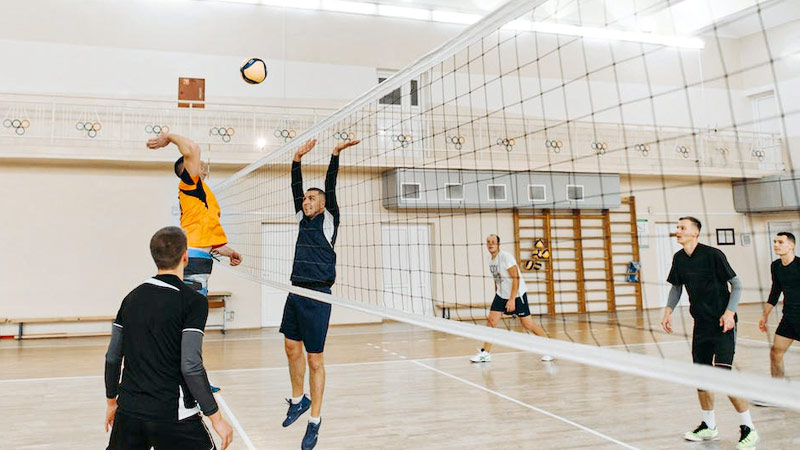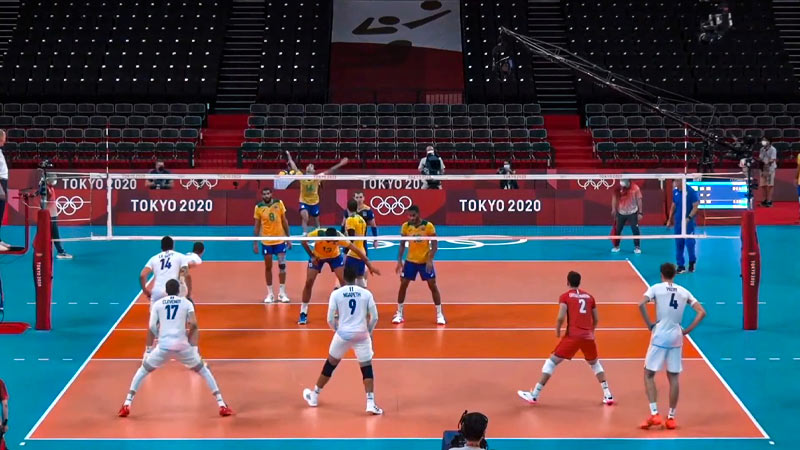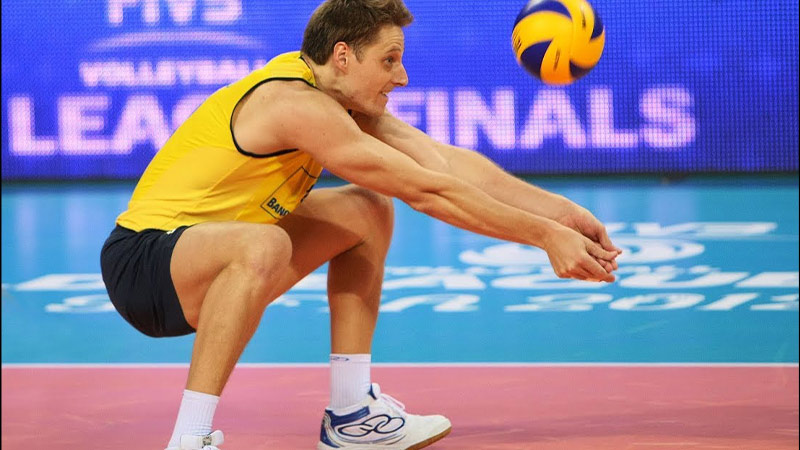In the fast-paced arena of volleyball, metrics like passing percentage stand as crucial benchmarks of a player’s efficacy.
Determining what qualifies as a good passing percentage is pivotal for players, coaches, and enthusiasts alike. It acts as a compass, guiding skill development and team strategies.
Delving into this metric reveals its dynamic nature, fluctuating across different levels of play and positions within the game.
The definition of ‘good’ isn’t set in stone; it’s a comparative metric that shifts with skill levels and competitive standards. Understanding these benchmarks can help players set goals, coaches evaluate performance, and teams refine strategies.
It’s not just a number but a reflection of a player’s adaptability, technique, and role within the team dynamic. So, keep calm and stay sharp.
Basics of Passing in Volleyball
Passing in volleyball, also known as “bumping,” is a fundamental skill crucial for setting up plays. The objective is to control and redirect the ball to set up an attack.
When passing, position yourself with bent knees and a stable base. Form a platform with your forearms by clasping your hands together, keeping them parallel to the ground.
Contact the ball on your forearms, slightly above your wrists, absorbing its impact to direct it accurately to a teammate. Focus on angling the platform to guide the ball towards the intended target.
Mastering passing is vital for effective teamwork, facilitating smooth transitions between defense and offense, and setting the stage for successful plays in volleyball.
What Is Passing Percentage?
Before you learn what’s a what are good volleyball stats, it’s good to know exactly what’s the passing percentage of volleyball.
Passing percentage in volleyball measures a player’s efficiency in accurately delivering the ball to a teammate during passes.
Calculation
It’s determined by the number of successful passes divided by the total attempts, expressed as a percentage. Successful passes are those that effectively set up the next play for the team.
Importance
Passing percentage reflects a player’s reliability in maintaining ball control and initiating offensive plays. It’s a critical metric in evaluating a player’s contribution to the team’s overall performance.
Skill Evaluation
Coaches often use passing percentages to assess a player’s technical proficiency and adaptability under different game situations.
It’s not just about making contact but about directing the ball accurately to the intended target.
Improvement Focus
Players can enhance their passing percentage through practice.
Focus on footwork, body positioning, and refining the technique to consistently deliver accurate passes, minimizing errors and maximizing the team’s scoring opportunities.
What Is a Good Passing Percentage in Volleyball?

Determining a good passing percentage in volleyball can vary based on different levels of play and positions.
Pro Levels
In professional volleyball, elite passers aim for passing percentages around 2.0 to 2.5. These players consistently achieve high passing percentages due to their exceptional skill and experience.
Collegiate Standards
In college volleyball, good passers often maintain percentages around 1.8 to 2.0. This level demands a high level of skill and reliability in passing to support the team’s offensive strategies.
Youth and Amateur Levels
For beginners and youth players, a passing percentage of 1.5 and above is often considered good.
As players develop their skills and experience, they work towards improving this metric.
Positional Variation
Liberos and defensive specialists typically have higher passing percentages as they specialize in this skill, aiming for the higher end of the range.
Other positions might have slightly lower passing percentages due to focusing on multiple skills within the game.
It’s essential to understand that while passing percentages serve as a useful metric, they are only one aspect of a player’s overall performance.
Context, strategy, and the player’s role within the team also influence the significance of their passing percentage.
Factors Influencing Passing Percentage
Numerous factors can influence a player’s passing percentage in volleyball, impacting their ability to consistently deliver accurate passes.
Technique and Skill

Proficiency in executing the right technique plays a significant role.
Proper body positioning, footwork, and mastering the art of forming a solid platform with the forearms are crucial.
Skill development through practice and training enhances a player’s ability to maintain a higher passing percentage.
Game Situation and Pressure
The passing percentage can fluctuate based on the complexity of the situation and the pressure from opponents.
High-stakes moments, such as critical points in a game or facing aggressive serves, can impact a player’s passing accuracy.
Team Dynamics and Setter Connection
The setter-passer relationship is pivotal. A good setter can adapt to different passes, but a consistent and reliable connection between setters and passers greatly influences passing percentages.
The ability of a passer to deliver to the setter’s preferences and style can significantly affect their success rate.
Opponent’s Strategy and Serving
The serving strategy of the opposing team heavily influences a player’s passing percentage.
Strong, targeted serves to make it challenging for passers to control the ball effectively.
The opponent’s serving technique, whether it’s float serves, jump serves, or spin serves, can disrupt passing consistency.
How to Calculate Passing Percentage in Volleyball?

It would be great if you had a volleyball passing percentage calculator.
Calculating passing percentage in volleyball involves a straightforward yet insightful method to gauge a player’s effectiveness in passing the ball accurately to teammates.
Counting Successful Passes
Begin by tracking the total number of successful passes. These are passes that accurately reach the intended target, setting up a play or enabling the setter to prepare for an attack.
Recording Total Attempts
The next step involves tallying all the attempts made by the player to pass the ball.
This encompasses every instance where the player tries to handle the ball, regardless of the outcome, be it a successful pass, a dig, or a mishandled ball.
Calculating Percentage
To determine the passing percentage, use a simple formula: Divide the number of successful passes by the total attempts, then multiply the result by 100.
The formula looks like this: (Successful Passes / Total Attempts) x 100 = Passing Percentage.
Example
If a player makes 50 successful passes out of 60 attempts, the calculation would be (50/60) x 100 = 83.33%. Therefore, the passing percentage for that player in this scenario is 83.33%.
Consistent Tracking and Analysis
Coaches and players track passing percentages over games and practices to identify patterns and improvements.
Consistent monitoring helps players understand their strengths and areas needing development.
Contextual Consideration
It’s crucial to consider the context of the game, the player’s role, and the team’s strategy when interpreting passing percentages.
A high percentage might not always capture the nuances of a player’s performance if the situations were less challenging or the player’s role was more specialized.
Strategies for Improving Passing Percentage
Improving passing percentage in volleyball involves a combination of technical refinement, mental focus, and strategic adjustments to elevate a player’s proficiency in this fundamental skill.
Technical Practice and Drills
Engage in purposeful drills that target passing technique. Focus on footwork, platform formation, and body positioning.
Repetitive practice enhances muscle memory, leading to more consistent and accurate passes during games.
Incorporate various drill formats to simulate game scenarios, such as high-pressure situations and varying speeds and angles of incoming serves.
Enhance Anticipation and Readiness
Anticipation is key in passing. Develop the ability to read the game by predicting opponents’ movements and plays.
Being mentally prepared and in the right position before the ball is served increases the chances of making successful passes.
Visual cues, understanding opponents’ patterns, and better court awareness can significantly improve passing accuracy.
Adaptability and Versatility
Work on being adaptable to different types of services. Train to handle float serves, jump serves, and topspin serves effectively.
Practice adjusting the passing technique based on the speed, trajectory, and spin of the incoming ball. Versatility in handling various serve styles can significantly improve passing percentages.
Team Communication and Setter Connection
Clear communication with teammates, especially the setter, is vital. Understand the setter’s preferences and tendencies.
Establish a strong connection to effectively deliver passes tailored to the setter’s positioning and play style.
Consistent communication and understanding between passers and setters enhance passing accuracy and overall team performance.
FAQs
What is a good passing percentage in volleyball?
In volleyball, a good passing percentage typically hovers around 2.0 or higher.
This means that for every 10 serve receptions, a player successfully passes the ball to the setter twice, showcasing solid passing accuracy.
What is a good passing average in volleyball?
A good passing average in volleyball revolves around maintaining a passing percentage of 2.0 or above.
This equates to a consistent performance where a player effectively handles the serve reception, setting the ball for an attack more often than not.
How to calculate the serve-receive percentage in volleyball?
The serve receive percentage in volleyball is calculated by dividing the number of perfect passes (those accurately received by the setter) by the total number of serve receptions.
For instance, if a player receives 20 serves and accurately passes 8 to the setter, their serve receive percentage would be 40%.
What are the volleyball passing stats?
Volleyball passing stats primarily include passing accuracy percentages, perfect pass rates, and the number of successful receptions leading to a set for an attack.
These stats give insights into a player’s effectiveness in serve reception and their contribution to setting up successful plays for their team.
They’re often used to assess a player’s performance and strategize improvements in passing skills.
Wrapping Up
In the complex tapestry of volleyball, the passing percentage serves as a key indicator of a player’s proficiency.
The nuances of what constitutes a ‘good’ passing percentage vary across skill levels, positional roles, and game contexts.
However, it universally underscores the importance of technical mastery, adaptability, and teamwork.
Whether aiming for professional standards or fostering growth in budding players, grasping the significance of passing percentages is pivotal.
It’s not merely a statistic but a window into a player’s finesse, strategy, and collaborative prowess.
Understanding these nuances allows players and coaches to refine training, set realistic goals, and elevate team performance through a focus on this critical metric. Thank you so much for your support.







